As you know, iMovie is a world-famous video editing software application designed by Apple Inc. It can be used on devices running macOS, iOS, or iPadOS. However, it’s very disappointing that you can’t play iMovie files on any Windows device. So, Windows users would ask - can I export iMovie to MP4 so that they can play it on their PCs. Fortunately, you can. This post from the free file converter will show you the detailed steps to do that.
What Is iMovie
If you are an Apple fan, you must be familiar with iMovie, which is a video editing application designed by Apple for its devices running macOS, iOS, or iPadOS. The slogan for iMovie is “Turn your videos into movie magic”, which means this app can help you create a stunning custom movie easily by using the videos and clips you have. You can start the video editing work on one Apple device and then pause it for some reason; after a while, you can pick it up on the same device or use another device to continue and even finish the work.
What Video Format Does iMovie Support
Many people are asking for help online for solutions to export iMovie to MP4. You may be strange when looking at this since iMovie says it supports MP4. You’ll be wondering what file formats iMovie supports. Let’s talk about them in detail. Knowing the supported video formats helps you understand what types of files you can import to iMovie and what you can export from iMovie.
What are the supported iMovie import formats?
- DV & HDV: DV, the full name is digital video, refers to the format to store digital videos recorded by common camcorders. In contrast, HDV refers to the format to record high-definition video on DV cassette tape. For a long time, HDV has been an affordable high-definition format for digital camcorders. The DV or HDV videos are usually uncompressed or only compressed with a lossless format.
- MPEG-4 (.mp4): MPEG-4 is also known as MPEG4 part 14 or MP4; it’s a multimedia format to store both video and audio data. Besides, it can also save subtitles and even still images. This is a good choice for iMovie if you want a video with a smaller size than DV/HDV.
- MPEG-2: also known as H.222/H.262, MPEG-2 is a standard for “the generic coding of moving pictures and associated audio information”. This format is used widely by digital television videos and videos saved on DVDs. (What if your Windows Media Player won’t play DVD?)
- QuickTime Movie (.mov): as the name suggests, the QuickTime Movie is the default video format used by QuickTime. One or more tracks can be contained in this format and what’s amazing is that each track can store various types of data: audio, video, or text (e.g. for subtitles).
- AVCHD: the full name of AVCHD is Advanced Video Coding High Definition, which is a file-based video format. It’s used on high-definition consumer camcorders & cameras to record and play high-definition videos. The MPEG-4 AVC/H.264 is used to compress video data of AVCHD files while the Dolby Digital/Linear PCM system was used to compress audio data.
- M4V: M4V is an MPEG-4 video container format designed by Apple and used in the iTunes Store. It’s very similar to MP4, but they are not the same. M4V is one of the good choices for iMovie. (What is M4V, how to open it, and convert M4V to MP3?)
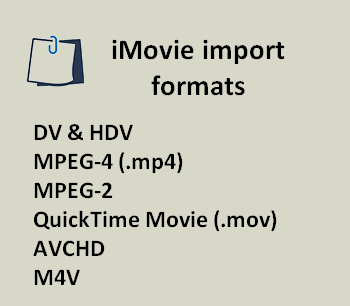
What are the supported iMovie export formats?
- DV & AIC: AIC stands for Apple Intermediate Codec, which is an intermediate format used in an HDV and AVCHD workflow. The size of DV files and AIC files are large, but they keep the high quality.
- QuickTime Movie (.mov): as the default video and audio format used in QuickTime, the MOV is also a supported export format from iMovie.
- AAC: the full name of AAC is Advanced Audio Coding, which is used for lossy digital audio compression. When compared to MP3, AAC has higher sound quality at the same bit rate. It’s no wonder AAC is considered the successor of the MP3 format.
- JPEG: JPEG is a format adopted widely by still images. However, it can also be used in videos exported from iMovie. Though its size is only half of the normal video files, it has high output quality.
- MP4: MP4 is also known as MPEG-4 part 14, which is a digital multimedia container format that is used frequently to store audio, video, subtitles, and still images.
AVI To MPEG: What’s The Difference & How To Convert
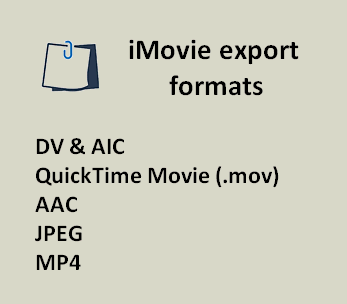
Does iMovie Support Mp4
The fact is only the MP4 files that use MPEG-4 or H.264 codec can be supported by iMovie. If there are any other kinds of codes used in your MP4 file, iMovie won’t give support to it. That’s why iMovie says it supports MP4 files but users can’t import their MP4 videos sometimes. In this case, you can convert the MP4 videos to iMovie-compatible format before importing.
MPEG4 VS MP4: What Is The Difference & How To Convert
What about the best iMovie video formats and audio formats?
- If the resolution of the source videos is under 720p, the best iMovie video format is Apple Intermediate Codec (AIC) with an extension of .mov.
- If the resolution of the source videos is 720p or higher, the best iMovie video format is HD 720p AIC or HD 1080p AIC with an extension of .mp4.
How to Save iMovie as MP4
You can export the iMovie projects you’ve made or export your videos edited by iMovie easily. The file will be saved to a location you choose on the computer and it will appear as a .mp4 file if you’re using iMovie 10. However, this MP4 file is not the same as your other normal MP4 files; it’s a .mp4 file that uses the same codecs that can be found in a .mov container.
Note: If you share at Best Quality (pro res), the video will be saved as a .mov file.
In the following content, I’ll show you how to export iMovie to MP4, how to save the iMovie project as a .mov file, and how to convert MOV to MP4 one by one.
iMovie to MP4 Mac
How to Open iMovie on Mac
- Open Finder on your Mac as usual.
- Select Applications from the list.
- Look for the iMovie icon (a purple star with a video camera icon inside) and press on it.
How to Create a New Project
- Shift to the Projects tab at the top of the software.
- Click on the Create New button (represented by an add icon in the middle).
- Select Movie to get the greatest amount of freedom to edit videos later.
- You can also select Trailer to insert your video footage into various pre-set editing and transition filters.

How to Import Video to iMovie
- Shift to the Media tab.
- Click on the Import Media button (represented by a down arrow icon).
- Browse your drive to find the file you want to import.
- After that, you can edit your video in iMovie at will.
Another way to import a file more quickly is: dragging and dropping the file into the iMovie browser.
How to Save iMovie as MP4
The steps to export iMovie to MP4 include:
- Navigate to the top right corner of iMovie.
- Click on the Export button.
- Select Export File or File from the pop-up small window.
- Adjust the export settings if you want.
- Click Next at the bottom right.
- Give a name to the file so that you can recognize it quickly later.
- Choose where to save the file on your Mac and click Save.
- Wait for the process to finish.

You can also follow this to save an iMovie file:
Select File from the top menu bar -> navigate to the Share option from the drop-down menu -> select File option from the submenu -> repeat steps 4 ~ 8 mentioned above.
FREE!!! How To Convert An MP4 Video To MP3 (Win & Mac)
Can you Export iMovie to .mov
Yes, you can. Please follow these steps:
- Open iMovie on your computer.
- Click on the Export button in the top right corner.
- Select Email from the drop-down menu.
- Then, your email application will be opened and the clip file will be created in it automatically.
- Please right-click on this file and choose to save it to the local folder by following the on-screen instructions.
- After that, you should go to open the folder to see your .mov file exported from iMovie.
Can you convert iMovie to MP4 in this case? Please find your answer in the content below.
How to Convert MOV to MP4 on Mac & Windows
Convert .mov to MP4 on Mac
When talking about MOV to MP4 Mac, you may first think of QuickTime (the default media player for Mac), right? Yes, using QuickTime Pro for converting MOV to MP4 is a good choice.
- Install the QuickTime Pro on your Mac properly.
- Register with your account.
- Select File from the menu bar.
- Choose Open File from the drop-down menu.
- Browse your Mac to add the target MOV file to QuickTime.
- Click File again and choose Export this time.
- Select Movie to MPEG-4 and define where to save the file.
- Click Save and wait for the saving process to complete.

Convert .mov to .mp4 on Windows
You’ll be disappointed if you try to play the .mov files on Windows using Windows Media Player. A window will pop up to inform you that Windows Media Player cannot play the file. What should you do at this time? You need a MOV to MP4 converter. MiniTool Video Converter is ads and antivirus-free; it’s a safe tool to try when converting videos & audio.
How to Convert MOV File to MP4 with MiniTool Video Converter
MiniTool Video Converter is a free and user-friendly file converter. Firstly, its wide format support is a major advantage. No matter if you want to convert MOV to MP4, AVI, MKV, WMV, MPEG, MXF, ASF, MP3, ACC, AVC, etc. MiniTool Video Converter has got you covered.
Secondly, the ease of use makes it accessible to everyone. You don’t need to be a tech-savvy person to operate it. Its interface is clean and intuitive, so even if you are a beginner, you can navigate through the process easily.
Moreover, MiniTool Video Converter supports converting up to 5 files simultaneously. It also allows you to change the parameters for the output file.
Let’s see how to convert MOV to MP4 with MiniTool Video Converter.
Step 1. Click the button below to download and install MiniTool Video Converter on your computer.
MiniTool Video ConverterClick to Download100%Clean & Safe
Step 2. Open MiniTool Video Converter. Click on the Add Files button and select the MOV file you want to convert.
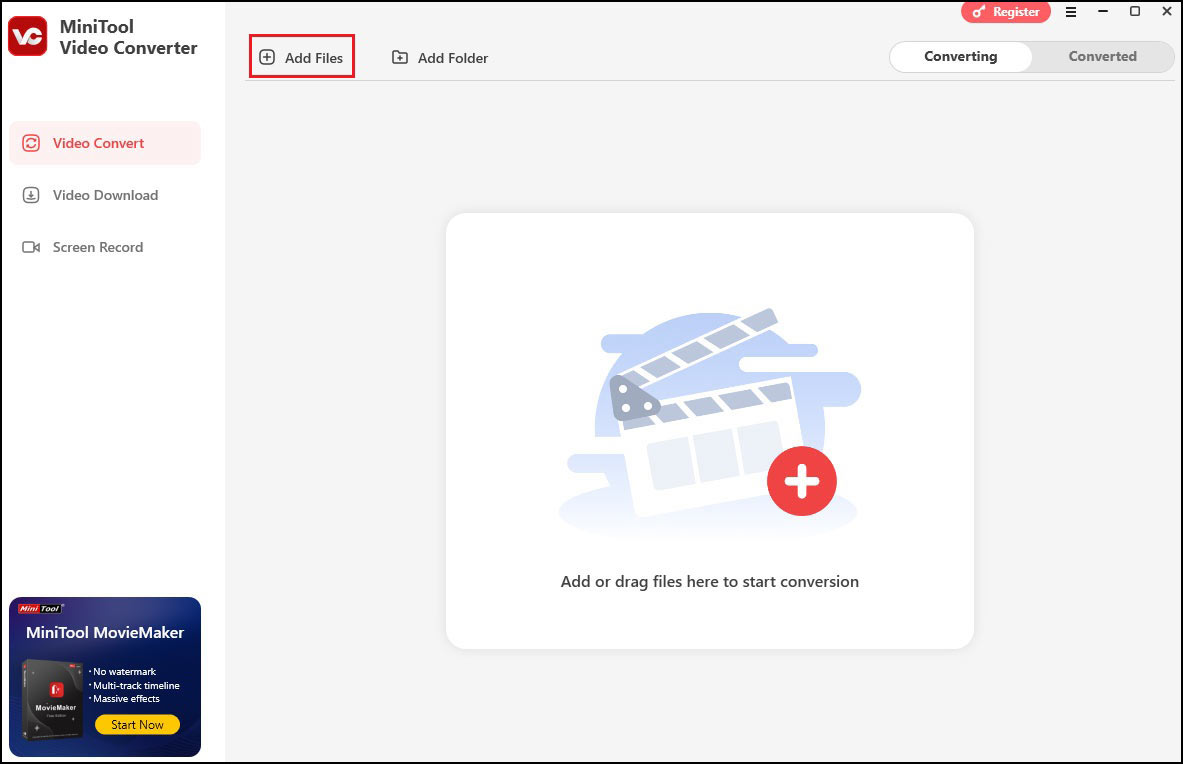
Step 3. Open the output format window by clicking the gear icon. Under the Video tab, select MP4 as the output format.
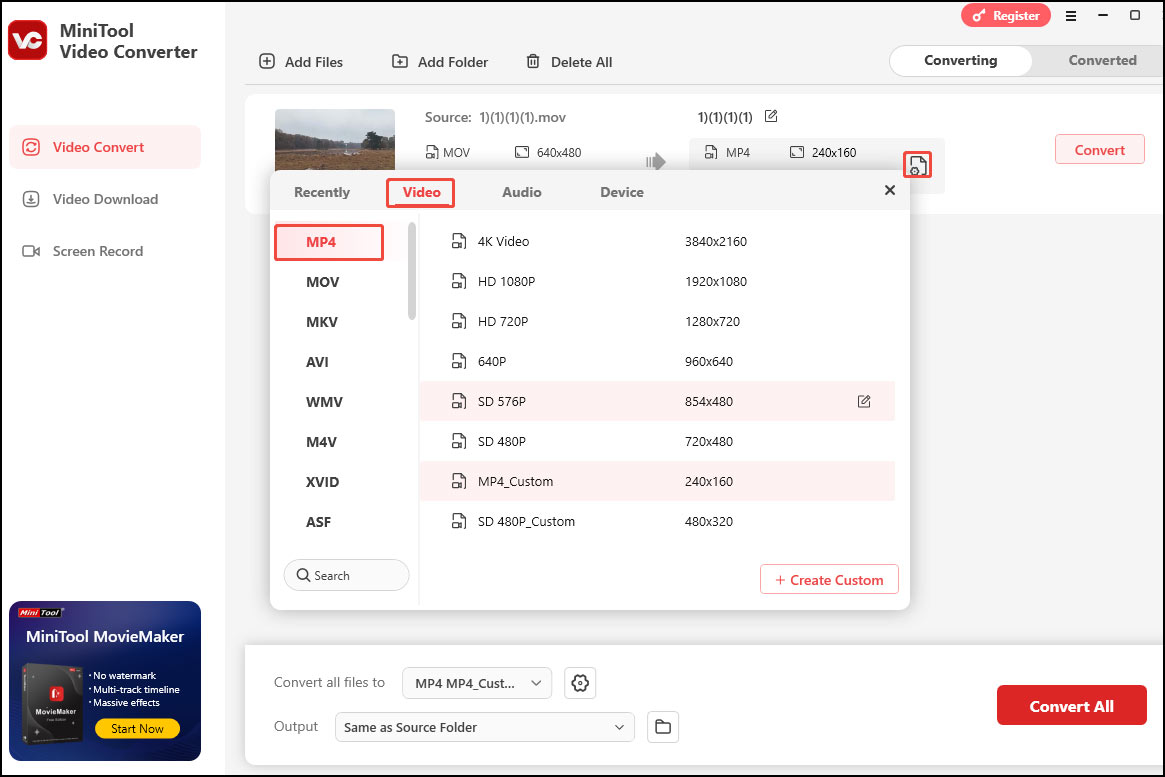
Step 4. Click the Convert button to begin the conversion process.
Step 5. Click Open to locate the converted file.
Convert .mov to .mp4 Online
There are also a lot of web-based MOV to MP4 converters available for both Mac and Windows users. I’ll introduce some popular ones to you and display the steps to convert MOV to MP4 by using them.
CloudConvert
- Visit CloudConvert’s official website.
- Click on the red Select File button in the middle.
- Browse your computer to select the .mov file and click Open.
- You can also click on the down arrow after it to select the .mov file by URL, or from Google Drive, Dropbox, & OneDrive.
- When your MOV file is loaded, you can click on the down arrow after Convert to. Then, select MP4.
- Click on the Convert button and wait for the conversion to finish.
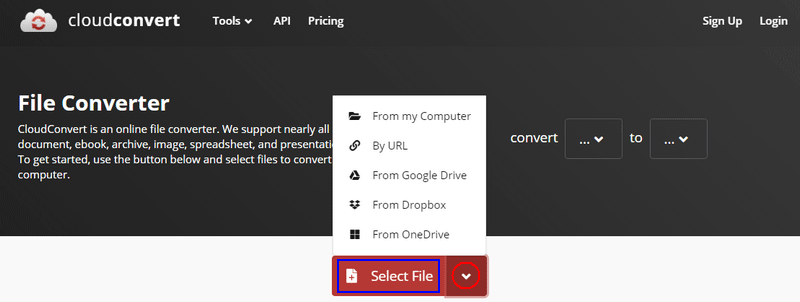
FreeConvert
- Go to the MOV to MP4 page of FreeConvert.
- Click on the blue Choose Files button in the middle.
- Browse and select your MOV file. Then, click Open.
- Click on the Convert To MP4 button and wait.

Of course, you can use other online converters like Zamzar and FreeFileConvert.
Please read this page to learn how to convert MKV files to MOV on Windows/Mac.
Bottom Line
iMovie is a good tool to play/edit videos and create new video projects for users. However, it can only be used on Apple products. What’s more, the iMovie files are not compatible with some media players people use. That’s why people need to export iMovie to MP4.
This page introduces iMovie first. Then, it shows you how to export iMovie to MP4/.mov. After that, it teaches you how to convert MOV to MP4 on Mac, Windows, or online.
Finally, if you have any questions while using MiniTool Video Converter, please contact us via [email protected].



User Comments :